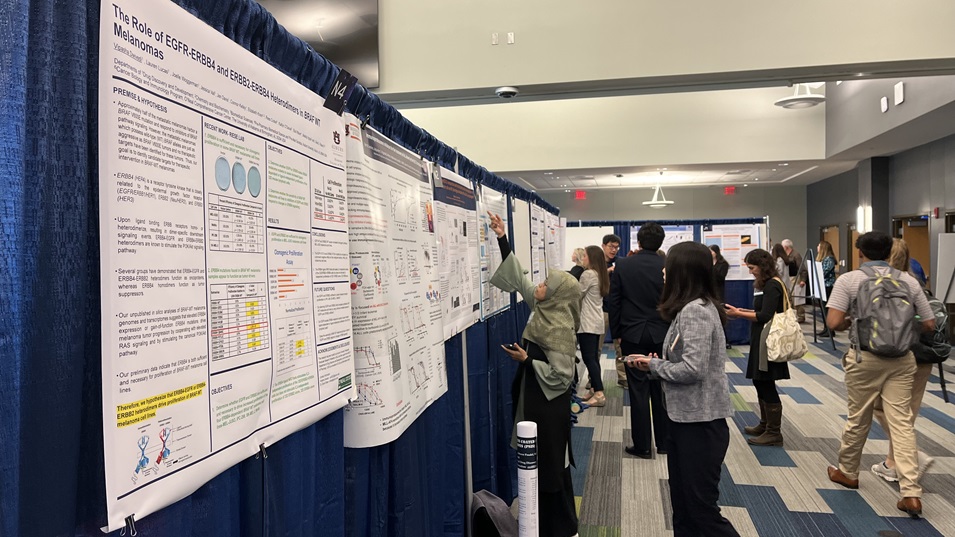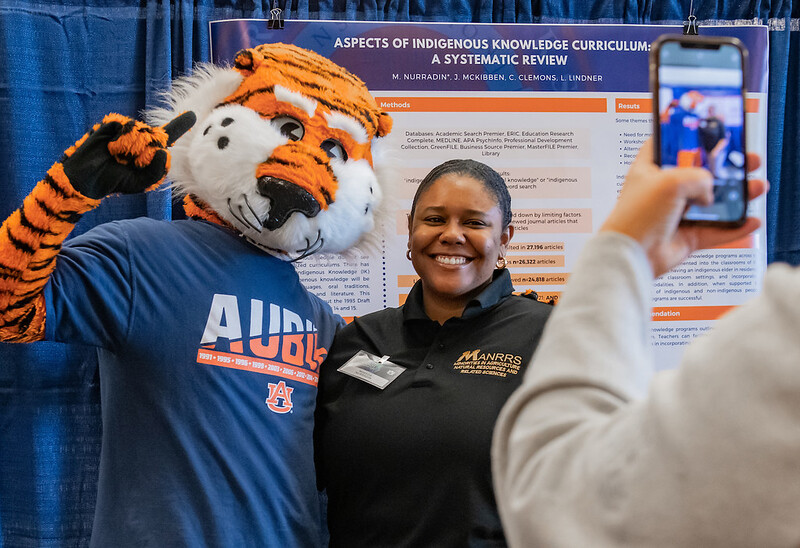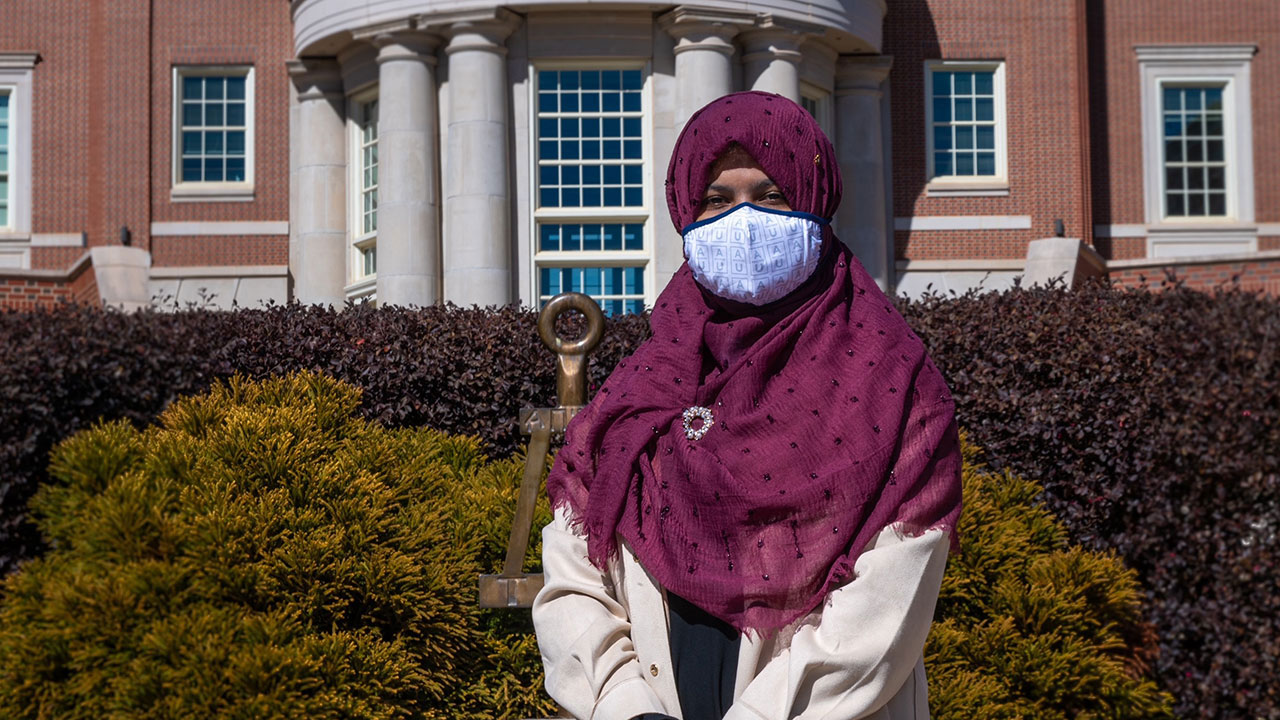Graduate Student Research News
Abstract submission now open for the 2024 Auburn Research Symposium
Abstract submission for the 2024 Auburn Research Symposium is now open and will close on Feb. 11, 2024. Undergraduate and graduate students are invited to participate through oral presentations, posters and creative scholarship displays. Postdoctoral researchers are also invited to participate through oral presentations featured during the symposium.
The event will be held on Tuesday, March 26, in the Auburn University Melton Student Center. Registration details, abstract guidelines and best presentations award criteria are posted on the Research Symposium website.

Categories: Graduate Student Research, Creative Scholarship, Undergraduate Research
Auburn Libraries offering savvy researcher bootcamp for AU graduate students
Auburn University Libraries will hold its fall semester savvy researcher boot camp over Zoom on Saturday Sept. 9, from 9 a.m.-3:45 p.m. The daylong event is designed for graduate students who want to take their research skills to a higher level. Whether students are interested in learning how to locate scholarly sources in their field, write a literature review, manage data, organize citations or present their research, the Savvy Researcher workshops will help them become better, more effective, researchers.
List of all workshops offered.
BY JASON HILL
Categories: Graduate Student Research
Student research symposium posters viewable on RBD Library digital wall
Posters from the 2023 Auburn Research Student Symposium are currently displayed on the digital wall in the Innovation and Research Commons of the Ralph Brown Draughon Library. The symposium is an annual spring event that shares student research and creative scholarship with a broad audience consisting of faculty, staff, graduate and undergraduate students and the public.
The Digital Wall is located on the first floor of the Ralph Brown Draughon Library and is available for viewing during all regular library hours.
More information about the Auburn Research Student Symposium. More information about the Digital Wall.
Categories: Graduate Student Research, Creative Scholarship, Undergraduate Research
Sixty-four students win awards at ‘Auburn Research: Student Symposium’
Sixty-four students took home awards for their research and creative scholarship posters and oral presentations during the recent “Auburn Research: Student Symposium.” Nearly 440 undergraduate and graduate students from Auburn University’s main campus and Auburn University at Montgomery participated in the annual symposium, which gives students an opportunity to share their work university-wide and with the general public.
“Congratulations to the award winners and to all of the students who participated,” said Lorenzo Cremaschi, director of undergraduate research. “Everyone did an outstanding job presenting their remarkable projects. Auburn has a wealth of talented student researchers.”
Undergraduate research awards
The undergraduate first-place award in the Science, Technology, Engineering and Mathematics poster presentations went to Alicia Taylor of Chemistry and Biochemistry. Catherine Walls of Poultry Science captured first place in the STEM oral presentations.
In the category for Human Sciences, Social Sciences, Creative Arts, Nursing and Humanities, Haley Shufflebarger of Interior Design won first place for her poster presentation, while Jordan Windham of Political Science took first in the oral presentations.
Graduate research awards
The graduate student first-place winner for the Science, Technology, Engineering and Mathematics poster presentations was Arthur Lamounier Moura of Forestry and Wildlife Sciences, while first place in the STEM oral presentations went to Claudia Rutland of Crop, Soil and Environmental Sciences.
In the category for Human Sciences, Social Sciences, Creative Arts, Nursing and Humanities, Sydney Waitz-Kulda of Psychology won first place in the poster presentations, while Priyadarshni Patel of Nutrition, Dietetics and Hospitality Management captured first in the oral presentations.
College-specific awards were also presented for undergraduate and graduate student categories. A complete list of winners, as well as titles of their projects, is available on the “Auburn Research: Student Symposium” website.
The Ralph Brown Draughon Library also plans an exhibit showcasing many of the winning posters. Details will be announced later about the exhibit.
BY CHARLES MARTIN

Aubie visits with Auburn student Makeda Nurradin of Curriculum and Teaching, who won third place in the graduate student poster presentations in the category, Human Sciences, Social Sciences, Creative Arts, Nursing and Humanities. Sixty-four students took home awards on the university and college levels.
Categories: Graduate Student Research, Creative Scholarship, Undergraduate Research
Entomology professor researching clothing materials designed to prevent mosquito bites
So, imagine you’re a female mosquito.
You’re patiently circling, waiting to pounce, while your unsuspecting victim enjoys a picnic with no idea they have unknowingly been placed on your menu. Your multi-lensed eyes have confirmed what your carbon dioxide-detecting and thermal-imaging sensory organs first alerted you to—a likely meal—and although your intended entree is wearing long sleeves, your proboscis, or mouth parts, include six razor-sharp, needle-like appendages that can easily penetrate the tiny spaces in the shirt’s weave.
A perfectly designed biting machine, you close in and stealthily alight on your target’s shoulder, plunging those bloodsucking daggers downward like you’ve done so many times before. But this time they bounce off the sleeve harmlessly. You try and try again, more frantically each time, but the unique weave of the fabric foils your bite and ruins your evening dinner plans. Frustrated, slightly bewildered, and with a noticeably bent proboscis, you drunkenly take flight to look for an easier meal. This time, man beats mosquito.
That’s the kind of “Bug’s Life” scenario that a team led by John Beckmann, assistant professor of entomology and plant pathology in Auburn University’s College of Agriculture, hopes to make an everyday occurrence through the development of a lightweight fabric that blocks mosquito bites while also being cool enough to wear during hot and humid weather.
Beckmann’s team includes students Alexa England, Kyle Oswalt, Natalie Wong, Richard Murphy and Bryan Holt, along with collaborator Jim McCann at Carnegie Mellon University. Their work was recently awarded an $868,145 grant from the Alabama Department of Economic and Community Affairs, or ADECA, one of three grants made to Auburn professors totaling $1.31 million overall.
Beckmann first came up with the idea of bite-proof clothing while brainstorming possible research projects in his back yard, although he swears it wasn’t a mosquito bite that inspired him. He did recall, however, an earlier Minnesota camping trip where deer flies bit him repeatedly through a heavyweight, long-sleeved shirt. That convinced him his idea was potentially useful, but the first step for him and his team was making sure that available “mosquito-proof” clothing wasn’t already doing the job.
Most bite-resistant clothing currently on the market is either impregnated with pesticide or made with thick, non-breathable fabrics that are both hot to wear, yet still easy for the insects to overcome. Another alternative is to cover oneself from head to toe in regular clothing, but even that gives a false sense of security.
“People say, ‘wear long sleeves’ a lot,” Beckmann explained. “But long sleeves don’t block mosquitos. There are also several companies out there that claim their fabrics resist bites, but we tested them and they really don’t. They’ve never solved the issue of the holes in the makeup of their fabrics, which allow the mosquitos to penetrate them.”
Beckmann says the vulnerability of current textiles lies in the weaving method, which leaves gaps the mosquitos can easily exploit.
“Clothing is constructed by taking a linear fiber and essentially weaving it over another fiber, or by looping loops, as in knitting,” he said. “Both these processes leave microscopic holes. It’s hard to see them with the naked eye, but if you hold your clothes up to the sun, you’ll see how much light shines through. Every one of those holes is far larger than the mosquito’s proboscis. So it’s actually very easy for them to bite through even supposedly mosquito-resistant clothing.”
Since they tested various shirts currently advertised as mosquito-proof by wearing them and sticking their arms into a tank full of the hungry mosquitos, Beckmann and his team know more than they want to about bites. Research can sometimes itch. But while the solution to the problem seems simple—find a way to eliminate the holes, or at least make them smaller than a mosquito’s proboscis—that’s easier said than done. Because not only is the Auburn group trying to design clothing that will resist bites, they are also trying to make that clothing cool and comfortable, which traditionally has meant using a breathable material that will allow air to circulate. And fabric breathability has always required holes.
“That is the precise reason why this project is not as easy as people think,” Beckmann noted. “You obviously need your clothes to be breathable. Paradoxically, that usually comes at the cost of letting mosquitos bite through them. So the basic problem is keeping the holes there while simultaneously sealing them off from microscopic mosquito mouth parts.”
A key to solving this paradox is the team’s acquisition of a CNC, or computer numerical control, knitting machine—thanks in part to the ADECA grant—that provides the ability to produce textiles at a very fine level of resolution. In comparison to traditional weaving, these so-called “weft-knitting” machines build textiles by interconnecting loops of yarn in a horizontal fashion. The result is multiple interconnected layers within a single seamless fabric, and the process is often referred to as “3D knitting.” With the added ability to use multiple types of yarn, CNC machines allow the fabrication of a much greater range of textile types and provide many more options of structural geometry.
“Alabama used to be a big source of textile manufacturing and research, and Auburn was a major part of that.” Beckmann said, “But over the last few decades, much of that manufacturing went overseas, and Alabama lost its place in the textile industry. The ADECA grant is to some degree attempting to help restore that place by establishing this knitting laboratory in Auburn. We want to do more with what we were given and bring Alabama back as a textile innovator and manufacturer.
“Another important thing to emphasize about the knitting lab,” he added, “is that we are looking for collaborations. There are applications in engineering, aerospace, fashion, art, entomology, agriculture and many other areas. With this CNC machine knitting and the ability to twist our own fibers, we are certainly capable of more than just mosquito-resistant textiles. We can potentially help with any textile research or with trying to make new textiles from novel inputs. So we are open for business, and anyone who wants to collaborate should directly contact me.”
For now, however, the first challenge for the new lab is mosquito-defeating apparel. While other researchers are working on that same problem, Beckmann says there is room for many potential solutions.
“Textiles are very complex and there are many variables that go into constructing them,” he said. “You can generate almost infinite iterations, and in that search space of theoretical textiles, some of those iterations will block mosquito bites and some won’t. And some of those materials will be comfortable and others won’t.
“It’s all about finding the best combinations,” he added. “Obviously, there are different brands of shoes, cars, etc. So there is room for more innovation. We hope to contribute to the field and generate the best product. With a few good minds contributing independently, the problem should get solved one way or another. That’s how science works.”
Beckmann and his team are also testing their results against a variety of mosquito species—hoping for a “one size fits all” approach than can resist multiple types. In the U.S. alone that means 176 different known species, while there are more than 3,000 species worldwide.
“What we hope to do is generate a product that blocks multiple mosquitos, not only the most common Aedes, Culex and Anopheles species,” Beckmann said. “But this has to be tested, and it’s one area that has not been tested enough. It is one definitive reason why what we are doing is different from other researchers. We are trying to explore all the worst mosquitos, and not just the easiest ones to culture.”
After a year of testing and gathering data, Beckmann and his team have developed a fabric that foils mosquitos with help from roboticist McCann at Carnegie Mellon, a researcher who programs knitting robots. But it is not yet as comfortable as they would like. The next step is to make it more breathable and cooler to wear.
“Think of it as athletic apparel that blocks mosquito bites,” Beckmann said. “The knitting machine lab is what allows us to try different methods of manufacturing. In the end, clothes have to be mass-manufactured. So you have to find a solution to the problem that is scalable. And that is what the knitting machines allow us to explore.”
Eventually, Beckmann hopes to repay ADECA’s investment in the idea many times over by developing a product that can be made in Alabama, bringing new industry and jobs to the state.
“We hope to manufacture our product in state,” he said, “and we are already talking to business collaborators within Alabama to begin setting up that process. But we have a long road still ahead.”
But if Beckmann and his Auburn team succeed, it will be a sweet—and notably bloodless—victory in the long, ongoing war between people and mosquitos. Enjoying the outdoors without fighting off hordes of the hungry, biting insects will be as easy as slipping on the right clothing, and that clothing will hopefully be made in Alabama.
The only real losers will be the mosquitos. For once, being a mosquito will bite in a whole new way.
BY MIKE JERNIGAN

John Beckmann, Auburn University assistant professor of entomology and plant pathology, examines mosquitos as part of his research on material to block mosquito bites.
Categories: Graduate Student Research, Manufacturing, Agriculture
Student passionate about inspiring women to pursue education in computer science
Sanjana Ruhani Tammim received her first computer when she was just five years old and instantly fell in love with the endless possibilities it offered.
“I was very engaged with this computer from the day I received it,” she said. “My family wanted me to become a doctor as they believed that would be a suitable profession for me as a female. But I loved computers and I wanted to be an engineer. With computers, you can choose your own path.”
Not only did Tammim, a first-year doctoral student in computer science and software engineering, choose her own path – she’s passionate about helping young women pursue their computer education dreams and open pathways of their own.
“I dreamed about working with computers,” said Tammim, who earned undergraduate and master’s degrees in information technology from Jahangirnagar University in Bangladesh. “Not all women in my country envision themselves as engineers, however. I was privileged to choose the career path I wanted. Therefore, my vision and passion are to encourage women beyond race, color and backgrounds to pursue their dreams.”
Tammim works as a graduate research and teaching assistant in the college’s Laboratory for Education and Assistive Technology directed by Daniela Marghitu. She was invited to develop her skills as a computer scientist and collaborate with experienced professionals at the prestigious 2022 Computing Research Association Grad Cohort for Women April 21-23 in New Orleans.
“It is a great honor to attend this notable graduate cohort for women in computer science and engineering and I am confident this cohort will provide me with tremendous opportunities to meet people and build networks who have similar interests,” Tammim said. “Moreover, I will enjoy face-to-face, insightful learning moments from fellow female researchers and mentors. I am thrilled to meet a diverse group of women who, I am assured, will support me to believe that I am not alone and will encourage me to thrive on my PhD journey.”
Grad Cohort for Women attendees will spend two days interacting with 20 senior female computing-related researchers and professionals, who will share pertinent information on graduate school survival skills, as well as more personal information and insights about their experiences. The workshop will include a mix of formal presentations and informal discussions and social events.
“Women at the conference, like me, will gather to motivate students, share their experiences and research topics,” Tammim said. “We will learn fresh ideas that we can apply to our own academic careers and learn how we can follow their examples. I also look forward to learning from peer students.”
Tammim hopes to learn fresh approaches she can apply to her own research: developing systems for assistive technology.
“I am currently working on developing learning systems that help children with special needs,” said Tammim, already an experienced classroom lecturer, who desires a full-time academic role once her doctorate is completed. “Some of these tools include augmented reality and virtual reality. I began this research last semester. There’s still a long way to go.”
BY JOE McADORY

Sanjana Ruhani Tammim
Categories: Graduate Student Research, Science, Technology, Engineering and Mathematics (STEM), Engineering


